What is Security Service Edge (SSE)?
Security Service Edge (SSE) is a cloud-centric security framework that integrates multiple essential security services into a unified, streamlined platform delivered from the cloud. SSE primarily focuses on securing user access to applications, data, and resources, regardless of the user's location or the hosting environment (cloud, on-premises, or hybrid).
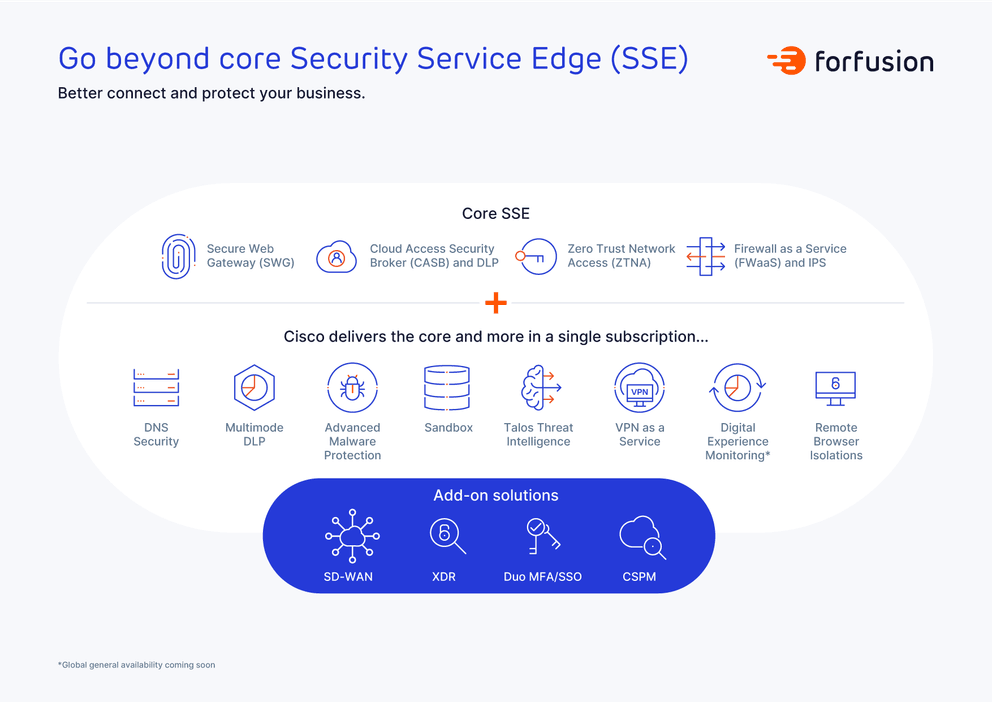
Core SSE Components:
- Secure Web Gateway (SWG)
- Cloud Access Security Broker (CASB)
- Zero Trust Network Access (ZTNA)
- Firewall as a Service (FWaaS)
We'll discuss these components in detail in the following sections.
Why SSE Matters?
In today's evolving digital landscape, businesses face increasing complexity as users, applications, and data continue to spread across multiple environments, including on-premises, hybrid, and cloud-based infrastructures.
This is where Cisco Secure Access steps in, offering a converged, cloud-delivered security solution designed to simplify your security posture and empower your hybrid workforce.
What is Cisco Secure Access?
Cisco Secure Access is Cisco’s flagship Security Service Edge (SSE) solution and is designed to provide a converged security approach, bringing together the key elements of an SSE solution and much more, allowing organisations to confidently support remote workforces, manage application access efficiently, and ensure seamless yet secure connectivity from any location.
One of the core strengths of Cisco Secure Access is its emphasis on Zero Trust principles when connecting to private applications, verifying users and devices continuously, no matter where or how they connect. Cisco implements adaptive access controls, assessing contextual factors like user identity, device posture, application sensitivity, and real-time threat information. This context-aware security ensures that access permissions are dynamic and aligned with current risks and organisational policies.
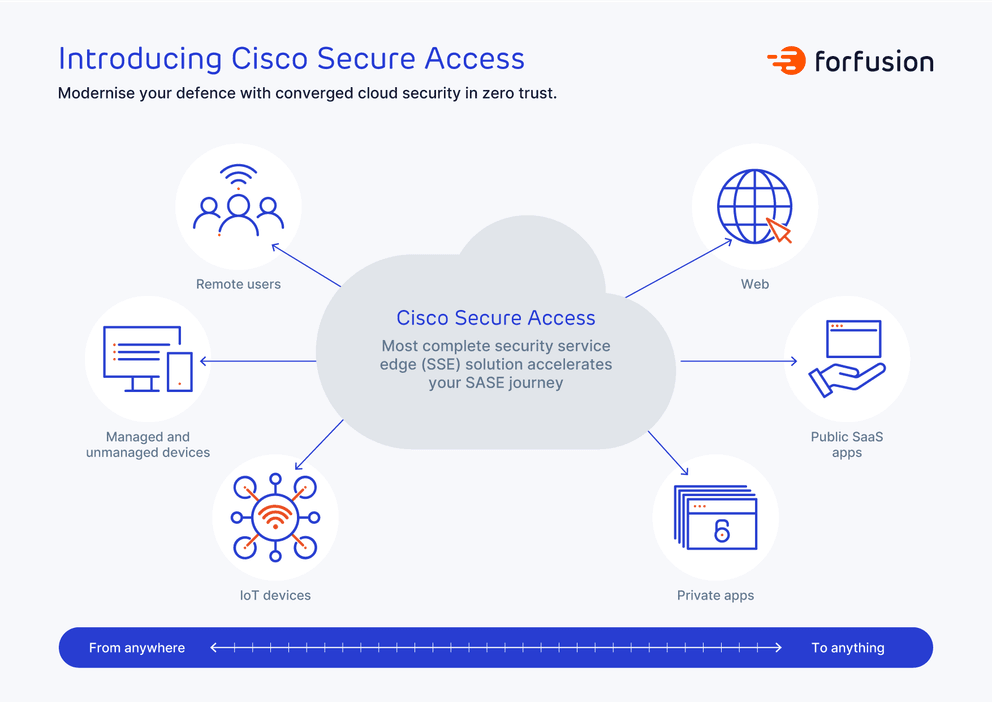
Think of SSE as moving connectivity closer to the destination, rather than the source. Traditionally, the network security perimeter would have been at either a HQ or Data Centre location with all security services provided there. User traffic would tunnel over to the hub location and egress from there. There was often no security services provided for users that were not on a VPN when they were not on the company premises.
With SSE, it doesn't matter where you are connected, whether physically on the corporate network, at a customer site, or a coffee shop —you get the same protection and user experience. Where firewalling was previously performed at the hub site, it can now be done in the cloud. There's no need for on-premises web proxies; these are now hosted in the cloud.
Key Features of Cisco Secure Access
Let’s break down what makes it powerful:
Cisco Secure Client
Cisco Secure Client is included with Secure Access at no added cost. With Secure Client installed, end users can transparently leverage ZTNA features, VPN connectivity, and much more with a single client.
DNS-layer Security
The first line of defence. Stops threats before they reach your network by blocking access to malicious domains using Cisco Umbrella’s powerful threat intelligence.
Secure Web Gateway (SWG)
Protect users from internet-based threats by decrypting and inspecting all web traffic, enforcing policies, and blocking malicious content like malware, phishing attacks, and unsanctioned websites without compromising speed or performance. Log web traffic for greater transparency, control, and protection. Protects users from malicious websites, phishing, and other web-based threats.
Zero Trust Access
Provide granular, app-specific secure access to private apps in on-premises data centres or in cloud/Infrastructure as a Service (IaaS) environments. Only the right users gain access to the right applications, based on identity, device security, location, and other factors. You can enforce least-privilege access without making users jump through hoops. Secure Access offers Client-based access via the Cisco Secure Client, the single, unified client for Secure Access, as well as Clientless access (via browser) to protect traffic to web apps (http/https) and private apps with browser-based SSH and RDP protocol support, which significantly expands the apps that can be protected via clientless ZTNA.

VPN as a Service (VPNaaS)
Not all private apps can be secured by ZTNA. With its VPNaaS option, Secure Access provides cloud-delivered secure access to all private apps (not just some), including those apps not supported by ZTNA.
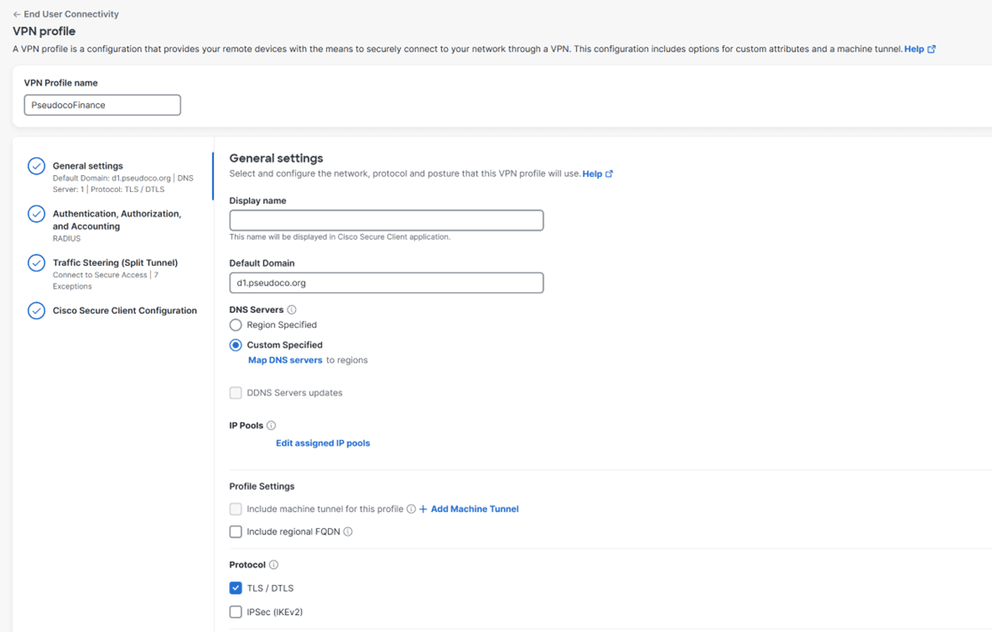
Cloud Access Security Broker (CASB)
Detect, report on, and block selected cloud apps in use, including generative AI. Manage cloud adoption and block use of offensive, non-productive, risky, or inappropriate cloud apps to reduce risk. Multimode capabilities to detect, log and control user/group activities.
Data Loss Prevention (DLP)
Multimode Data Loss Prevention (DLP) offers both in-band and out-of-band detection capabilities. Analyse data in-line to provide visibility and control over sensitive data leaving your organisation. API-based functionality for out-of-band analysis of data at rest in the cloud. Unified policies and reporting for more efficient administration and regulatory compliance.
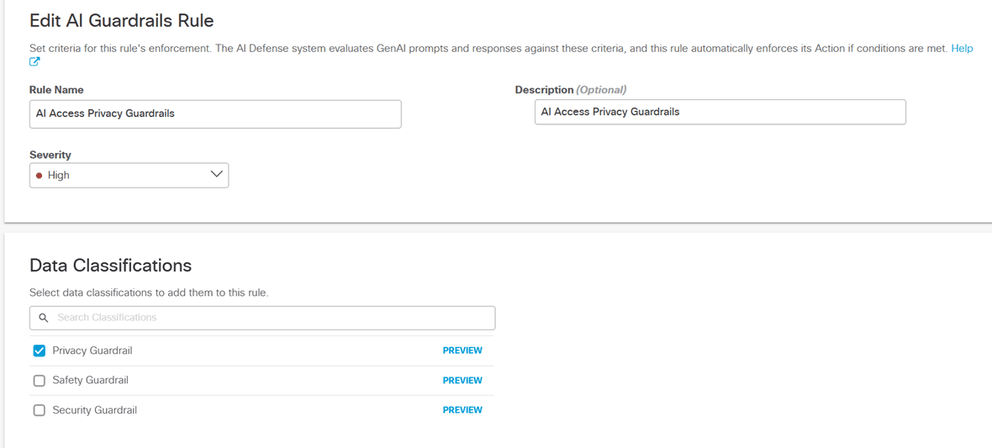
Firewall-as-a-Service (FWaaS)
A Layer 7 next-generation cloud-delivered firewall provides full visibility and comprehensive security controls for traffic between users and destinations/apps on the Internet or in the customer’s private infrastructure, across all ports and protocols. Includes remote users accessing the Internet or private apps while they are roaming or from a branch office campus network.


Remote Browser Isolation (RBI)
Keeps users safe from risky websites by isolating browser activity in the cloud. Threats never reach the endpoint as the user is only accessing a secure, cloud-hosted browser with no direct interaction with the client browser.
Cloud Malware Detection
Detects and removes malware from cloud-based file storage apps. Enriches security protection by detecting and remediating malicious files before they reach an endpoint.
Resource Connectors
Resource Connectors simplify administrative tasks to set up secure connectivity to private apps, regardless of whether they are in an on-premises data centre or the cloud. Supports AWS, Azure, and VMWare. Additionally, Resource Connectors in Docker Containers provide a cloud-agnostic solution for deploying Resource Connectors, enabling broad connectivity across various environments.
Analytics & Automation
Leverages powerful analytics and automation capabilities. Security teams benefit from enhanced visibility across network traffic, cloud environments, and user behaviours, facilitating quicker detection and response to potential threats.
Unified Management Platform
By reducing complexity through a unified management platform, Cisco Secure Access allows IT teams to efficiently implement and adjust security policies, ultimately improving overall productivity.
User Experience
Cisco Secure Access greatly enhances the user experience. Employees enjoy seamless access to necessary applications and data without cumbersome authentication processes, significantly boosting efficiency and collaboration in a hybrid work environment.
AI Assistant
Generative AI capability that helps security administrators save time, improve operational efficiency, and reduce complexity.
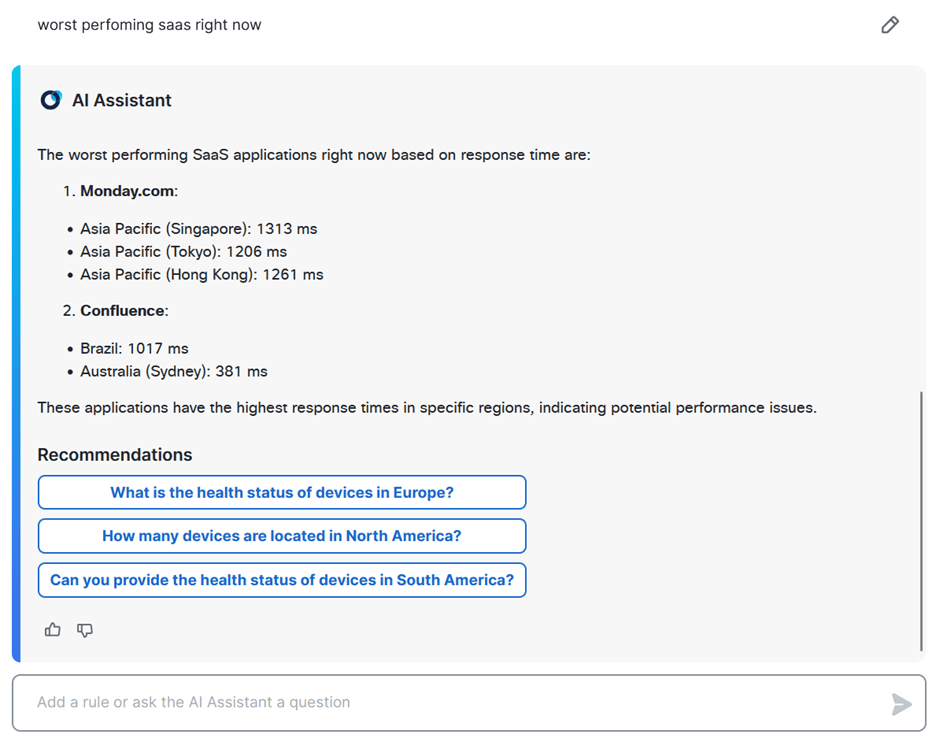
Digital Experience Monitoring
Monitor health and performance of endpoints, apps, and network connectivity as users access resources. Optimise user productivity, simplify troubleshooting, and reduce time to resolution of incidents by automatically capturing details on the user’s end-to-end experience. Integrated AI-driven insights help you proactively identify and mitigate potential performance issues, ensuring a more resilient environment.
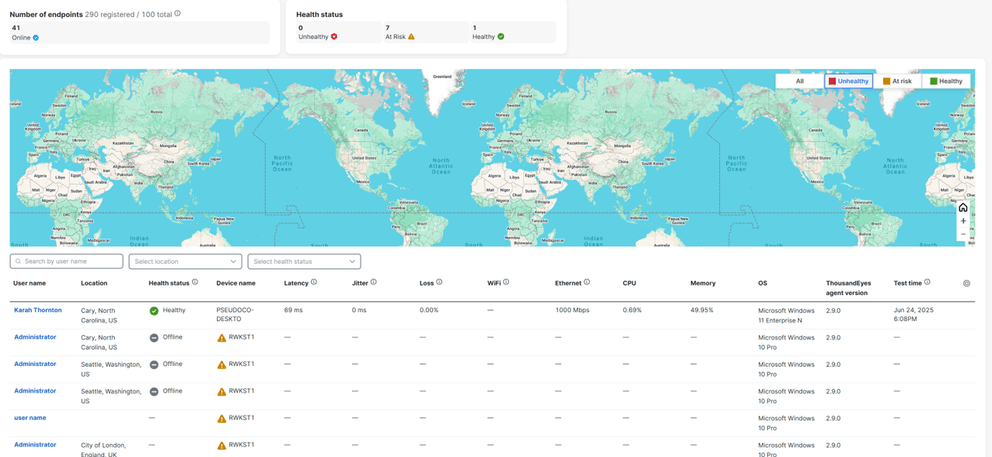

SD-WAN Integration
Integration and automation between Catalyst SD-WAN and Secure Access enables steering from branch users to the web and SaaS apps to be protected by Cisco Secure Access.
Cisco Identity Services Engine (ISE) Integration
Cisco ISE and Secure Access integration provides granular, identity-based information to deepen visibility into what users are doing, when, and how. It enriches policy control and enforcement for internet and SaaS app traffic to reduce the attack surface of the network and limit potential lateral movement of threats.
Common SSE Use Cases
Cisco Secure Access addresses a multitude of modern security challenges, with two overarching use cases:
- Secure Internet Access (SIA): Ensuring that all internet-bound traffic from users, regardless of their location, is securely inspected and filtered for threats. This includes protecting against malware, enforcing acceptable use policies, and securing access to public SaaS applications.
- Secure Private Access (SPA): Providing secure, least-privileged access to private applications hosted in your data centres or private clouds. This leverages ZTNA principles to grant access only to authorised users and devices based on continuous verification.
Why Choose Cisco Secure Access for SSE?
Cisco combines decades of security expertise with a cloud-native approach to deliver scalable, efficient, and future-ready SSE capabilities. Whether you're modernising legacy security, enabling hybrid work, or managing cloud risk, Cisco Secure Access is built to simplify your journey
Ready to Secure Your Cloud-First Enterprise?
Schedule a personalised demo with one of our security experts to see how Cisco Secure Access can power your SSE transformation. Talk to our team.

